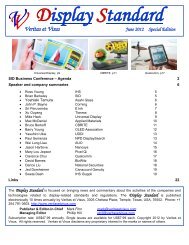You also want an ePaper? Increase the reach of your titles
YUMPU automatically turns print PDFs into web optimized ePapers that Google loves.
<strong>Veritas</strong> <strong>et</strong> <strong>Visus</strong> <strong>Display</strong> <strong>Standard</strong> February 2009<br />
Green technology in flat panel displays<br />
David Hsieh is vice president of the Greater China Mark<strong>et</strong> for <strong>Display</strong>Search. David<br />
joined <strong>Display</strong>Search from HannStar <strong>Display</strong> where he was a key account manager<br />
responsible for both notebook and LCD monitor accounts. Prior to two years in<br />
HannStar's sales and mark<strong>et</strong>ing department, Hsieh served for a total of five years as<br />
production planner and production engineer at HannStar's TFT LCD module line and<br />
Hitachi Kaohsiung's STN LCD module line. Hsieh is fluent in Taiwanese, Mandarin,<br />
Japanese, and English and holds a degree in Industrial Engineering from Chung-Yuan<br />
Christian University.<br />
89<br />
by David Hsieh<br />
With “green” becoming an increasingly important concept in many flat panel display<br />
applications and the evolution of technologies to enable green displays, it’s no surprise<br />
that green flat panels are beginning to take off and will become the most important trend in the FPD industry for the<br />
next decade. <strong>Display</strong>Search reports that in 2008 20% of FPD shipments were green, and this share is expected to<br />
soar to 70% by 2012 and dominate the mark<strong>et</strong> by 2014. <strong>Display</strong>Search has created a new topical report dedicated to<br />
Green FPD – Green Technology in Flat Panel <strong>Display</strong>s: Mark<strong>et</strong> Technology & Trends – which examines<br />
environmental regulations, power-saving technologies, eco-friendly components, energy-saving manufacturing<br />
processes, and panel structure simplification efforts of the main three kinds of FPD, TFT LCD, OLED and plasma.<br />
<strong>Display</strong>Search defines green flat panel displays as those which me<strong>et</strong> one of the following conditions: using<br />
environmentally friendly components and materials; achieving lower power consumption by using new components<br />
or technologies; compliant with environmental regulations such as waste disposal; using production processes that<br />
reduce energy and materials consumed; compl<strong>et</strong>ely or partially recyclable after useful life; or use of green or ecofriendly<br />
concepts in product design, packaging m<strong>et</strong>hods or materials. David Hsieh, vice president of <strong>Display</strong>Search<br />
and the author of the report, specifically uses a chart, shown as Figure 1, to describe the green perspectives in the<br />
flat panel display industry.<br />
Cost Reduction<br />
Eco-Friendly<br />
Components<br />
� Product re-design<br />
� Low mercury<br />
� Components reduction<br />
� Eco-friendly<br />
components adoption<br />
� New display<br />
technology (such as<br />
OLED, e-paper,<br />
MEMS-based display)<br />
Panel Design<br />
Energy Saving<br />
Production<br />
� New processes in the fab<br />
to reduce the electricity<br />
and water consumption<br />
� Production efficiency<br />
improvement<br />
� Photomask reduction<br />
Figure 1: Green techniques for flat panel displays<br />
Environmental<br />
Regulation<br />
Power<br />
Consumption<br />
Reduction<br />
� Panel transmittance up<br />
� New optical film in the<br />
backlight unit to reduce<br />
power consumption with<br />
the same brightness<br />
� Luminous efficiency<br />
improvements<br />
� LED backlight






